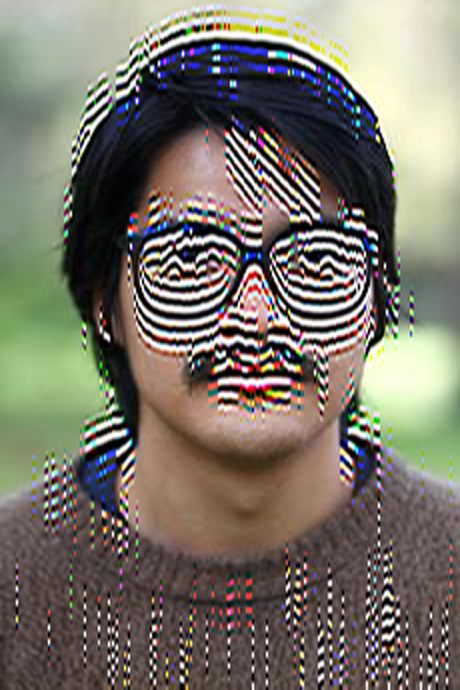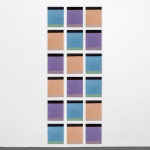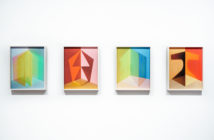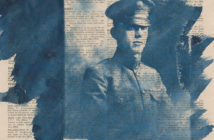 Carlos Jiménez Cahua
Carlos Jiménez Cahua
Untitled #65.p (My [Aesthetic] Vocabulary Did This To Me; bicubic), 2012
Tiff file, dimensions variable
This is part two of a conversation about the artist-in-residence program sübSamsøn, directed by Camilo Alvarez, interviewed a few days ago. The current artist in the Gallery's basement studio is Carlos Jiménez Cahua, who ends his 6 month residency this month.
Stephanie Cardon So Carlos, how did you approach this 6 month residency? That's a long time to be 'in residence'. Did you have a particular project in mind or let it evolve organically?
Carlos Jiménez Cahua My goal was simply to spend as much time in the studio as I could. Other residents like John C. Gonzalez used the monthly structure of the First Fridays to present new month-long, collaborative pieces. I used that monthly exhibitive aspect almost like a grad school critique wherein I would present what I'd been working on for the past month and that month only, such that, particularly for repeat visitors, there was a detailed progress (or regress) report on what I was doing—so, ideally, others would know precisely what was going on in my practice.
SC What have you been working on?
CJC In the beginning, I continued work I'd done in the tail-end of graduate school, making camera-less (and negative-less) color analog prints, which could be termed photograms, but I find that term imports certain aesthetics and bodies of work (e.g., that of Man Ray or László Moholy-Nagy) I don't necessarily find myself akin to. My making those prints came from treating the paper not as a passive surface waiting for images or imagery, but rather, as an agent unto itself, whose own material particularities (specifically, its rectangularity, color gamut, and compliance to folding and shaping outside the plane) bore a significant causational relationship to the final product. With this I hoped to achieve two things: firstly, parse an un(der)-explored visual language unique to analog, photographic paper (which, generalized, is in some sense a Modernist endeavor), and secondly, highlight the materiality of an often ignored aspect of photographs, namely the print, or made less specific, its objecthood.
More recently, I've migrated some of my formalist, Modernist and Structuralist interests to other media, like sculpture, video, projection works, and paintings. There are many reasons for this move which are too numerous and under-ripe to go through.
SC Did being below the gallery in proximity to so much other work by other artists have an impact you in any way? Any eureka moments, changes in heart?
 Carlos Jiménez Cahua
Carlos Jiménez CahuaInstallation View: Ich will doch nur, daß ihr mich liebt; für t, 2012
Eighteen 10x8-inch chromogenic color prints
65 x 26 inches (installed)
CJC The work of Camilo's artists is informally displayed outside my basement studio, so I'd spend a lot of time looking at work of Summer Wheat, Steve Locke, and Matt Rich, among others. From that there certainly came some influence; for instance, for a set of pieces, rather than naming them sequentially (e.g., Untitled #x [where x is the next highest number after the previously titled piece]), I gave them the name, Ich will doch nur, daß ihr mich liebt..., which from German translates to "I only want you to love me." Apart from being the title of a Fassbinder film, it's influenced by some of the cheeky, maudlin titles Steve Locke has given to some of his recent work; the title of his last show at Samsøn was "You Don't Deserve Me."
There was a slow Eureka moment with Victoria Fu's show at Samsøn, the second show during my residency. In it she had these two beautiful films, shown as 16 mm prints. Commercially speaking, a collector of one of these would, in addition to the print, receive an archival, digitized version of the piece, and this really got my mind going. I thought of an analogous situation in photography whereby someone purchasing a picture (which, to the point of nearing ubiquity, exists as a digital file before being reified as a print, at least from lens-based photographers) would also receive a full-quality digital file; I haven't done the requisite study, but I'd guess a typical photographer would object, and perhaps not so politely, if you asked her for this. Yet, there's an openness from artists working with the moving image, and those working digitally only have the option of providing the video file for commerce. So with that in my head, I started making these pieces where I take a digital image file, often found on the internet or provided by others, and (leaning on some of my Structuralist thinking) alter it ad nauseum using simple transformations in Photoshop, and that's that. I make no print of it. The medium of the piece is Tiff file, and that's just what someone receives who acquires the piece. To further borrow from the exhibitive workings of video artists, and perhaps hyperbolizing that, I make absolutely no demands when it comes to displaying the Tiff file(s). For instance, I showed some of these works in January in sübSamsøn, for which I approached Camilo (being the master of that domain) with the files and asked him to tell me how to show it—we could do anything you can do with an image file: print on a coffee mug, make a poster, make a slide to put in a carousel, print archivally as a common, fine art print, project on a wall, provide a link on a website, etc. He decided on life-size prints on three different types of paper, which ended up being office paper, glassine and brown wrapping paper. And this play with digital files has led to deeper investigations of the grammar of digital imagery to uncover a distinct aesthetics thereof, thereby linking back to previous vehicles of interest.
SC Socially what has the experience been like? Has Camilo offered you any critical feedback or left you to your own devices? How about encounters with other people—curators, gallerists, artists, critics or collectors—were those facilitated for you?
CJC Having Camilo as (essentially) a studiomate has been really great. He both provided feedback and let me do what I want, the latter of which was never crazy, but if it were, I know he'd be okay with that too. He got me organized with respect to the career aspects of being an artist, such as having documents (CV, documentation, press, etc.) updated and getting smart about keeping and getting in touch with people. Also, he invited interested folks for studio visits, from which I've begun to cultivate some nice relationships. Further, with Samsøn being a very active gallery and in a focal point for visual art in Boston, there were always interesting people wandering in, who he and his employees always tried to get into the studio.
SC I asked Camilo this same question, but I'm interested in your take on it. There's an unusual power dynamic in hosting someone's creative practice within the space and context of an art gallery, and yet it is a nurturing gesture towards this city's artists. I'm so conflicted about this! Help me out!
CJC The power dynamic was something I was interested in too. It can certainly be seen as skewed out of my favor but that unbalance quickly evaporated for two reasons: firstly, the view of the gallerist and artist as master and slave, respectively, is a caricaturized one (of which, for sure, there are neat examples, but whose diversity is certainly too wide to square in any certain terms of power), and secondly, and more specific to my situation, Camilo is a very easy-going and generous person. Proof of that admittedly subjective (and at this point, biased) characterization is the following: there has never been, for me, an uncomfortable situation at sübSamsøn. I've only had the warmest encouragement from him and he's opened up all of Samsøn to any requests I've had, like using his equipment, his employees, and even his upstairs space (i.e., the gallery) for little projects I've done.
SC Also something I asked Camilo: Is this a model you'd encourage other galleries to adopt? And if so/not, why?
CJC It's hard to say. This is totally speculative, but I'd guess a scientific survey of gallerists would tell us most would not be interested in having a resident artist on the premises. I have only good experiences with sübSamsøn, but I can see a generalized situation involving, let's say, an un-enlightened or sub-ethical gallerist and/or, on the other end, an entitled, demanding resident artist, that whole thing getting really hairy. That said, under the right circumstance, I'd certainly love to see it happen elsewhere.
SC The inevitable question: what's next? I hate to ask it, it's always as though what's happening now and what has been accomplished isn't enough but, knowing you, there may be something cool lined up.
CJC Right, the dreaded question. I'm being a good First World artist and applying to all the opportunities available, that is, grants, residencies, etc., but nothing's in stone yet. I definitely have some plans post-sübSamsøn, but I'll defer to how I ended another interview a few years ago, referencing the saying that if you want to make god laugh, talk about your future plans—so, I won't make god laugh.
- Carlos Jiménez Cahua Untitled #72 (Native, blue output of a digital projector [i.e., one with no video input] pointed toward a television playing a loop of a video of pure yellow), 2013 Digital projector, CRT television with DVD video 20 x 22 x 56 inches
- Carlos Jiménez Cahua Untitled #71.p (Square piece of unprocessed, black and white photographic paper folded into cube [according to origami instructions] and each face thereof spray painted with a primary color [namely red, green, blue, cyan, yellow or magenta] in a different order each time; cubic structure then de-folded into original sheet of paper), 2013 Three 42×42-inch unprocessed gelatin silver prints with spray paint 42 x 156 inches (installed)
- Carlos Jiménez Cahua Installation View: Ich will doch nur, daß ihr mich liebt; für t, 2012 Eighteen 10×8-inch chromogenic color prints 65 x 26 inches (installed)
- Carlos Jiménez Cahua Untitled #61 (Fuji), 2012 Chromogenic color print, 20 x 16 inches
- Carlos Jiménez Cahua Untitled #65.p (My [Aesthetic] Vocabulary Did This To Me; bicubic), 2012 Tiff file, dimensions variable










